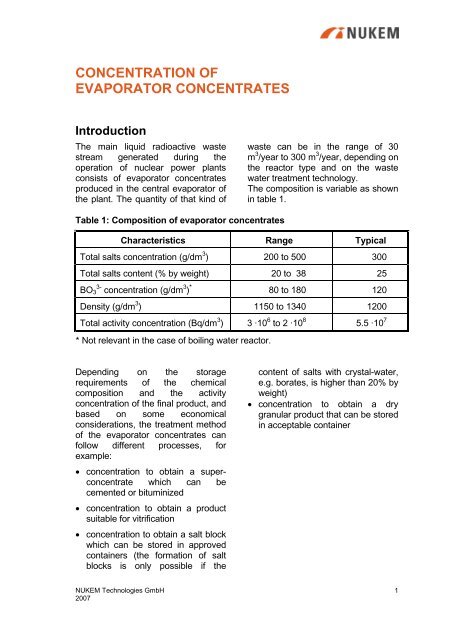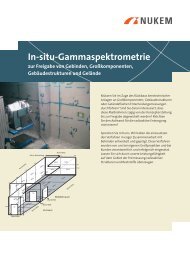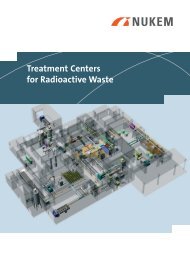Concentration of Evaporator Concentrates - NUKEM Technologies
Concentration of Evaporator Concentrates - NUKEM Technologies
Concentration of Evaporator Concentrates - NUKEM Technologies
Create successful ePaper yourself
Turn your PDF publications into a flip-book with our unique Google optimized e-Paper software.
CONCENTRATION OF<br />
EVAPORATOR CONCENTRATES<br />
Introduction<br />
The main liquid radioactive waste<br />
stream generated during the<br />
operation <strong>of</strong> nuclear power plants<br />
consists <strong>of</strong> evaporator concentrates<br />
produced in the central evaporator <strong>of</strong><br />
the plant. The quantity <strong>of</strong> that kind <strong>of</strong><br />
waste can be in the range <strong>of</strong> 30<br />
m 3 /year to 300 m 3 /year, depending on<br />
the reactor type and on the waste<br />
water treatment technology.<br />
The composition is variable as shown<br />
in table 1.<br />
Table 1: Composition <strong>of</strong> evaporator concentrates<br />
Characteristics Range Typical<br />
Total salts concentration (g/dm 3 ) 200 to 500 300<br />
Total salts content (% by weight) 20 to 38 25<br />
BO 3- 3 concentration (g/dm 3 ) * 80 to 180 120<br />
Density (g/dm 3 ) 1150 to 1340 1200<br />
Total activity concentration (Bq/dm 3 ) 3 ·10 6 to 2 ·10 8 5.5 ·10 7<br />
* Not relevant in the case <strong>of</strong> boiling water reactor.<br />
Depending on the storage<br />
requirements <strong>of</strong> the chemical<br />
composition and the activity<br />
concentration <strong>of</strong> the final product, and<br />
based on some economical<br />
considerations, the treatment method<br />
<strong>of</strong> the evaporator concentrates can<br />
follow different processes, for<br />
example:<br />
• concentration to obtain a superconcentrate<br />
which can be<br />
cemented or bituminized<br />
• concentration to obtain a product<br />
suitable for vitrification<br />
• concentration to obtain a salt block<br />
which can be stored in approved<br />
containers (the formation <strong>of</strong> salt<br />
blocks is only possible if the<br />
content <strong>of</strong> salts with crystal-water,<br />
e.g. borates, is higher than 20% by<br />
weight)<br />
• concentration to obtain a dry<br />
granular product that can be stored<br />
in acceptable container<br />
<strong>NUKEM</strong> <strong>Technologies</strong> GmbH<br />
2007<br />
1







